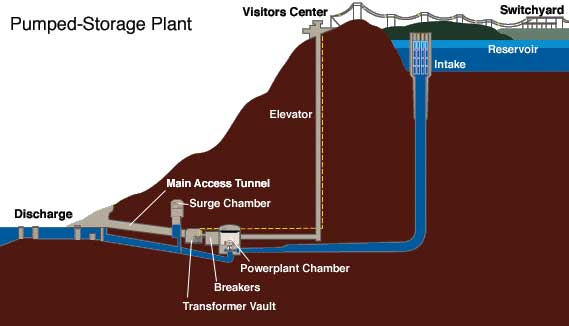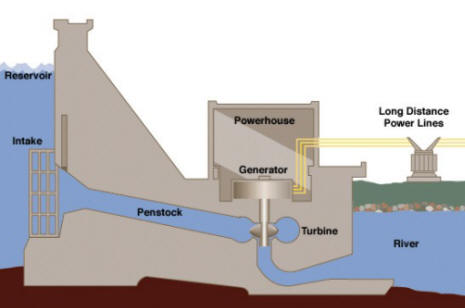Pumped-Storage HydroelectricityAs long as we have gravity and water, the electricity will flow.Pumped storage hydroelectricity is a method of storing and producing electricity to supply high peak demands by moving water between reservoirs at different elevations. 
The basics are simple. Store energy in a lake. Two lakes to be more precise. Use excess power, during low electricity demand periods or use otherwise unreliable power, to pump water from a lower lake to an upper lake and store it there until demand peaks. Then release the water from the upper lake down through shafts that drop around 1,000 feet in elevation, through a turbine, to create dependable power. Reversible turbine/generator assemblies act as pump and turbine. OK. So where do we get the electricity to pump the water to the upper lake? Today there are two readily available, untapped sources. The first will require a little bit of background to understand. Source One: Excess power from thermal base-load power plants. A base-load power plant is one that provides a steady flow of power regardless of total power demand by the grid. These plants run at all times through the year. They use a cheap fuel source such as nuclear energy or coal. Typically these plants are large enough to provide a majority of the power used by a grid. Base-load power plants do not change production to match power consumption demands since it is always cheaper to run them rather than running higher cost combined cycle plants or combustion turbines. Plus it takes too long, sometimes days, to bring them up to full production and to achieve a steady state power output. During peak demands, usually during the day, peak load plants that burn more expensive fuel such as oil or gas, and are quicker to bring on line are fired to help meet the demand. But the base-load plants run full speed 24/7. When the world sleeps we need less electricity. Since the base-load plants don't have a volume control, so to say, at times of low electrical demand, excess generation capacity is wasted - basically diverted to ground. During this low demand period the excess generation capacity, that is now being wasted, can be used to pump water into the higher reservoir of a gravity power plant. That is exactly how the largest pumped storage power station in the world operates. Coincidently, this station is located here in Appalachia at the Bath County, Virginia Pumped Storage Station, supplying power to millions of customers in six states. This facility was started after the oil embargo in the 1970's caused us to (at least for a while) realize our need to produce more energy from our own inexhaustible sources. Source Two: Intermittent or less reliable energy generation systems - nature. Another non-thermal way to power the up-flow for pumped storage is to utilize the fluctuating output of intermittent power sources. Wind Turbines. Wind power can be used to supply the current to pump water to the upper reservoir where it can be released to supply steady, controlled power into the electrical grid. Opponents of wind power argue that wind is undependable. That is a fine argument. But when the wind is blowing there will be enough power to run the pumps, or at least augment the power requirements for this step. Combined Hydroelectric Pumped Storage. Pure pumped-storage plants just shift the water between reservoirs, but combined pump-storage plants also generate their own electricity like conventional hydroelectric plants through natural stream-flow. If you are building one of these plants near a rapid mountain stream or river then this is an option. 
Solar. This may seem, at first, unworkable. Since it is already established that peak demand is during the day and the sun does not shine at night then the efficient use of solar power with a pumped storage project may require extra expense. It would require, perhaps a separate pumping system that recycles the water during the day (back up the mountain) while the turbine system is simultaneously generating energy from the down flow. All of these sources can be combined and pumped storage can be used to greatly reduce our need for oil and coal to produce electricity. One argument against these systems is the initial cost. The largest in the world cost $1.7 Billion (in 1985 dollars) to complete. But the cost savings or profits to the operators soar once they are on line. Where do you put them? Since this article was inspired by a desire to end mountain top removal then the idea of sinking a pond on top of a mountain might seem counter to the cause. Using abandoned MTR sites might be difficult because the nature of that practice usually destroys the water source needed to jump start the process by filling one of the lakes. But would it not be better to have one pond on top of a mountain than to see all the mountains destroyed? One of these plants can save hundreds of mountains. Some facilities can use surface ponds as the upper reservoir and abandoned mines or quarries as the lower reservoir. The options are not limited. Rivers can be tapped, as can great lakes and oceans. See the related page, linked at the bottom of this article for photos and examples. Visit Wikipedia for a list of pumped storage projects all over the world. The current count is around 150 plants with 25 of them located in the U.S. Other benefits. Recreation and stream protection. While it may seem novel for an energy producer to act as a good steward of the land, solving one of nature's 'gotcha' problems with pumped storage can result in a positive contribution to the surrounding environment. One of nature's gotchas is evaporation. The plant needs to replenish its daily loss of water. The solution is a supplemental storage system. The Bath County Pumped Storage Station, for example has a separate 325-acre public recreation area containing two lakes located just downstream from the lower dam. The area has facilities for fishing, non-power boating, picnicking, swimming, hiking and camping. Flows to nearby streams, are supplemented by storage from these reservoirs. This significantly improves stream flow during periods of drought and enhances the environment for fish and other aquatic life. Jobs. With its abundance of streams and mountains (for now) Appalachia could become the energy supplier for North America. Building and maintaining pumped storage stations could create thousands of high paying eco-friendly jobs. Hydrogen has been discussed, and often dismissed, as an alternate clean energy source. It does take more energy to produce or extract hydrogen than is produced by burning the resulting hydrogen. But what if the energy source were close to free, such as gravity fed water - a pumped storage system? Another article will surface here in the near future discussing hydrogen and sharing examples of the progress in this field. This is not just a future technology. Part of the municipal bus fleet in Reykjavik Iceland runs on hydrogen fuel cells. Admittedly the country has an abundant supply of earth energy that is used to create electricity via geo-thermal power plants. But the US, specifically California, has around 90% of the world's supply of borax. Hydrogen can be created through a chemical process and Daimler engineers are doing it today. This, of course, will be a much bigger discussion with, certainly, many opposing views. But it is our responsibility as visitors to this planet to explore ways to leave it as pristine or better than we found it. Extrapolative thinking. ... The word renewable is not used in this article because it has, perhaps been misused in the past. In essence, all energy transference is renewable as it passes from one state to another. But sun, wind, water and gravity are used only once at the point of consumption. If any of those forces ceased to exist, so would we. So we can call them, for the benefit of man, inexhaustible. Next: Photos and other Examples. [Printable version of this article in pdf]
Written and compiled by Agust Gudmundsson |